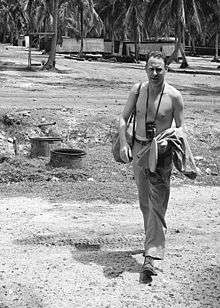Horace Bristol

Horace Bristol (November 16, 1908 – August 4, 1997) was a twentieth-century American photographer, best known for his work in Life. His photos appeared in Time, Fortune, Sunset, and National Geographic magazines.[1][2]
Early life
Bristol was born and raised in Whittier, California, and attended the Art Center of Los Angeles, originally majoring in architecture.[3] In 1933, he moved to San Francisco to work in commercial photography, and met Ansel Adams, who lived near his studio. Through his friendship with Adams, he met Edward Weston, Imogen Cunningham, and other artists. He was copy reader at night for the Los Angeles Times after graduating from Belmont High School.
Photography career
In 1936, Bristol became a part of Life's founding photographers, and in 1938, began to document migrant farmers in California's central valley with John Steinbeck, recording the Great Depression, photographs that would later be called the Grapes of Wrath collection.[2][3][4]
In 1941, Bristol was recruited to the U.S. Naval Aviation Photographic Unit, as one of six photographers under the command of Captain Edward J. Steichen,[5] documenting World War II in places such as South Africa, and Japan.[4] Bristol helped to document the invasions of North Africa, Iwo Jima, and Okinawa.[1][2]
Later life
Following his documentation of World War II, Bristol settled in Tokyo, Japan, selling his photographs to magazines in Europe and the United States, and becoming the Asian correspondent to Fortune.[1][4] He published several books, and established the East-West Photo Agency.[2]
Following the death of his wife in 1956, Bristol burned all his negatives, packed his photographs into storage, and retired from photography. He went on to remarry, and have two children. He returned to the United States, and after 30 years, recovered the photographs from storage, to share with his family.[2] Subsequently he approached his alma mater, Art Center College of Design, where the World War II and migrant worker photographs became the subject of a 1989 solo exhibition. The migrant worker photos would go on to be part of the J. Paul Getty Museum's Grapes of Wrath series.[2][6]
Bristol lived in Ojai, California, until his death in 1997 at the age of 89.[1]
Bristol's work is displayed around the world, including the Getty Museum[7] and the Los Angeles County Museum of Art.[8] In 2006, a documentary was made, The Compassionate Eye: Horace Bristol, Photojournalist, written and directed by David Rabinovitch.
Bibliography
- Ken Conner and Debra Heimerdinger. Horace Bristol: An American View. ISBN 0-8118-1261-8
References
- 1 2 3 4 Stuart Vail (2005). "Horace Bristol". Scream Online.com. Retrieved September 14, 2007.
- 1 2 3 4 5 6 The Horace and Masako Bristol Estate (2007). "Horace Bristol". The Horace and Masako Bristol Estate. Retrieved September 14, 2007.
- 1 2 Stephen Cohen Gallery (2007). "Horace Bristol". Stephen Cohen Gallery. Archived from the original on August 16, 2007. Retrieved September 14, 2007.
- 1 2 3 John Nichols Gallery (2005). "Horace Bristol (1908-1997)". John Nichols Gallery. Archived from the original on December 14, 2005. Retrieved September 14, 2007.
- ↑ Faram, Mark D. (2009), Faces of War: The Untold Story of Edward Steichen's WWII Photographers, pg. 45, Berkeley Caliber, New York, New York, ISBN 978-0-425-22140-2
- ↑ J. Paul Getty Museum (2003). "The Grapes of Wrath: Horace Bristol's California Photographs". Retrieved September 14, 2007.
- ↑ J. Paul Getty Museum. "Horace Bristol". Retrieved September 3, 2008.
- ↑ Conner, Ken (1996). Horace Bristol. San Francisco: Chronicle Books. ISBN 0-8118-1261-8.
External links
| Wikimedia Commons has media related to Horace Bristol. |
- Official website
- Gendell Gallery: Horace Bristol "The Naked Gunner" Photograph
- Frank Pictures Gallery - Works by Horace Bristol
- Exhibitions at The Getty Museum
- The story of Bristol's most famous photo
- The Compassionate Eye TV documentary about Bristol